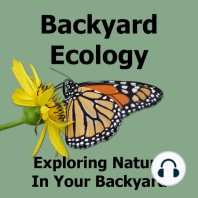57 min listen
Native and Non-native Earthworms in the Eastern U.S. with Mac Callaham
FromBackyard Ecology
ratings:
Length:
53 minutes
Released:
Dec 31, 2020
Format:
Podcast episode
Description
Hi Everyone! Today we are talking with Mac Callaham who is a Research Ecologist with the Southern Research Station of the U.S. Forest Service. Mac’s focus is on invasive species, with a specialty in soil animals, especially earthworms. Like many people, I grew up thinking that earthworms were a good thing and a natural part of our ecosystem. However, that’s not completely true. In North America, many of our earthworms were wiped out during the Ice Age either directly from the glaciers or because the ground, even quite a distance out from the glaciers, was frozen. We still have some native earthworms in the Pacific Northwest and parts of the southeast, but we also have quite a few non-native species of earthworms. Some of these non-native earthworm species have probably been here since the early European colonists arrived and brought their plants with them. Other species are much newer arrivals – some being discovered for the first time within the last few years. The impacts of these non-native earthworms depends on where they are found. In more northern parts of the continent, the effects of the non-native earthworms can be devastating to the ecosystem. This is because the local ecosystem existed for so long without earthworms in it. However, in areas where there were native earthworms, the impacts are often not quite so drastic, but that doesn’t mean there are no impacts. In many areas of the southeast, non-native earthworms are much more common than native species. Yet, even though the species composition has changed, we aren’t always seeing the same sort of dramatic impacts that are being seen further north. Part of that could be because those species have been in the southeast longer and part of it is likely that those species of non-native earthworms are doing some of the same things as the native earthworms in this area. However, some of the more recently discovered species of non-native earthworms can have quite drastic effects, even in the southeast, because their feeding behaviors are very different from the native species. Throughout this episode, Mac and I talk about the different types of earthworms, their impacts in various parts of the region, how much we don’t know, and how there really isn’t a simple, black and white answer when it comes to earthworms. Yes, non-native earthworms can have serious, negative impacts on the natural ecosystem, especially in parts of the continent. But in other areas, earthworms, even non-native species, can help soil health, especially in southern regions that have been highly impacted through long-term agricultural use. This is a complicated topic and we talk about some of those complications, including things that we as homeowners can do. Links: Southern Research Station Earthworm related Research Highlights from the Southern Research Station: Earthworms, Millipedes, and Soil Carbon in the Eastern U.S. Prescribed Fire to Stem the Tide of Earthworm Invasion Invasive earthworms have unexpected effects on other soil organisms Soil fauna are of vital importance to soil processes and deserve attention Short-circuiting an Invasional Meltdown Mac’s email: mac.a.callaham@usda.gov Other groups or researchers mentioned who are studying earthworms: Great Lakes Worm Watch, University of Minnesota Earthworms across Kansas, Kansas State University Bruce Snyder, Georgia College Josef Gorres, University of Vermont Katalin Szlavecz, John Hopkins University Books mentioned: The Formation of Vegetable Mould, Through the Action of Worms: With Observations on Their Habits (Classic Reprint) * Earthworm Ecology and Biogeography in North America * Backyard Ecology's website My email: shannon@backyardecology.net Photo credit: Yuanyuan Li
Released:
Dec 31, 2020
Format:
Podcast episode
Titles in the series (92)
Growing Native Plants in Small Yards: Growing Native Plants by Backyard Ecology
